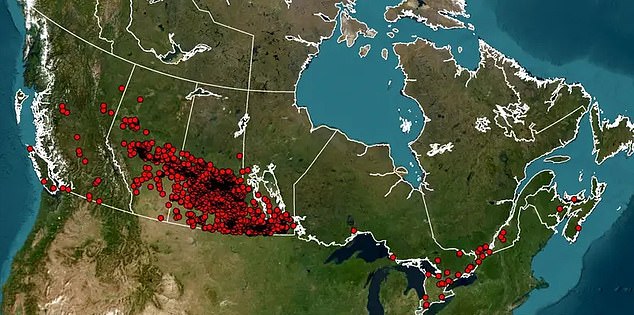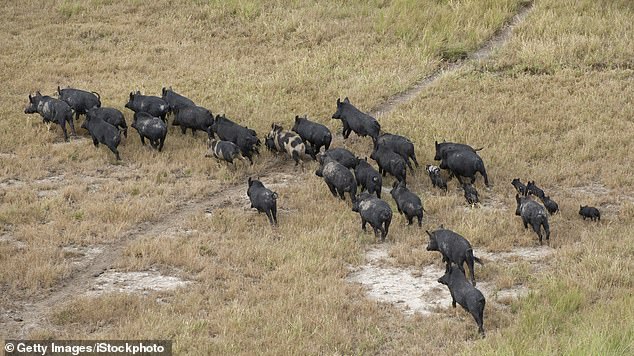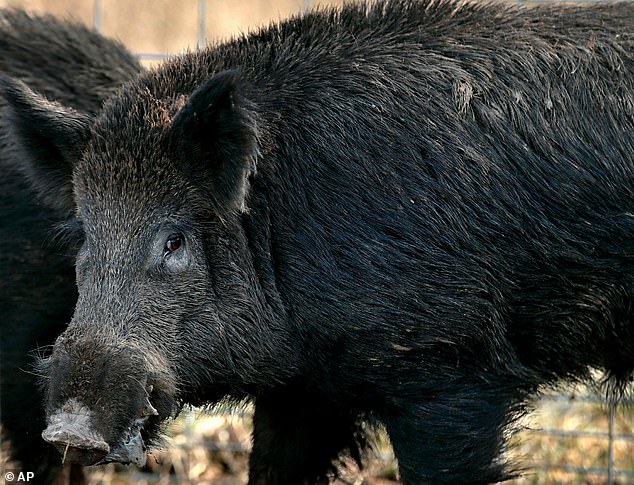Exploding population of ‘super hogs’ could spill over to the US from Canada and cause ‘an ecological train wreck’
>
- Researchers reported 62,000 sightings of wild boar in Canada this year
- They fear the population will spread to the United States, and Montana will be the first
- Read more: A man fell into a muddy puddle due to a huge pig in Canada
A growing number of “super pigs” in Canada could move to the United States, and experts fear the migration could cause an “environmental train wreck.”
Feral pigs are a hybrid subspecies that combines the survival skills of Eurasian wild boars with the size of domestic pigs and high fecundity, making them “the most aggressive animal on the planet.”
Wild boars can devastate agriculture and spread diseases to pig farms, such as African swine fever, which is deadly to both domestic and wild animals – and is not transmissible to humans.
Canadian researchers helping solve the problem have documented at least 62,000 wild hog sightings, including one just 18 miles from Minnesota.
Feral pigs are hybrid breeds that combine the survival skills of Eurasian wild boars with the size of domestic pigs and high fecundity, making them “super pigs.”
“Wild pigs are an ecological trainwreck,” said Ruth Asheim, a doctoral student at the University of Saskatchewan (USA).
“They are prolific breeders, making them a very successful invasive species.
“Wild boars can cause soil erosion, deteriorate water quality, destroy crops, and prey on small mammals, amphibians and birds.”
Pigs are not native to North America but were introduced from Europe in the late 1980s and early 1990s to diversify Canadian livestock production.
Other games were imported as “scripted” shooting games.
Hybrid wild boars have bred and spread rapidly, making them the most prolific invasive mammal in Canada.
They usually weigh between 120 and 250 pounds.

Canadian researchers helping solve the problem have documented at least 62,000 wild hog sightings, including one just 18 miles from Minnesota.

Wild boars can devastate agriculture and spread diseases to pig farms, such as African swine fever, which is deadly to both domestic and wild animals – and is not transmissible to humans.

Wild boars usually weigh between 120 and 250 pounds. They have about six piglets per litter per year
Wild boars roam Alberta, Saskatchewan and Manitoba, and could only be eradicated in Alberta, researchers said, because there are six piglets in a litter and two piglets are raised per year.
Ryan Brock, a professor at the University of Saskatchewan and one of Canada’s leading officials on the problem, said 65 percent or more of wild hogs could be killed annually, and that will continue to increase.
Canada’s pig problem dates back to the 1980s when officials encouraged farmers to raise wild pigs.
When the market collapsed in 2001, some farmers retaliated by cutting down fences and releasing the animals into the wild.
While many thought the invasive species would eventually die out, pigs have adapted to be the ultimate survivors of Canadian winters.
They can withstand extremely cold temperatures and breed in any season, living in “burrows” burrowed into the snow.
“No one should be surprised when pigs start walking across that border if they haven’t already,” Brock said. “The question is: What is going to be done about it?”
Brock said Montana has been the most serious about keeping wild hogs out. It banned the breeding and transportation of wild pigs within the state.
“The only way forward is to be really aggressive and use all the tools in the toolbox,” Brock said.
(tags for translation)dailymail
